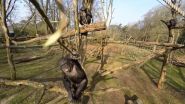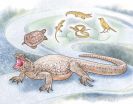(Press-News.org) CAMBRIDGE, Mass. -- The technology behind 3-D printing is growing more and more common, but the ability to create designs for it is not. Any but the simplest designs require expertise with computer-aided design (CAD) applications, and even for the experts, the design process is immensely time consuming.
Researchers at MIT and the Interdisciplinary Center Herzliya in Israel aim to change that, with a new system that automatically turns CAD files into visual models that users can modify in real time, simply by moving virtual sliders on a Web page. Once the design meets the user's specifications, he or she hits the print button to send it to a 3-D printer.
"We envision a world where everything you buy can potentially be customized, and technologies such as 3-D printing promise that that might be cost-effective," says Masha Shugrina, an MIT graduate student in computer science and engineering and one of the new system's designers. "So the question we set out to answer was, 'How do you actually allow people to modify digital designs in a way that keeps them functional?'"
For a CAD user, modifying a design means changing numerical values in input fields and then waiting for as much as a minute while the program recalculates the geometry of the associated object.
Once the design is finalized, it has to be tested using simulation software. For designs intended for 3-D printers, compliance with the printers' specifications is one such test. But designers typically test their designs for structural stability and integrity as well. Those tests can take anywhere from several minutes to several hours, and they need to be rerun every time the design changes.
Advance work
Shugrina and her collaborators -- her thesis advisor, Wojciech Matusik, an associate professor of electrical engineering and computer science at MIT, and Ariel Shamir of IDC Herzliya -- are trying to turn visual design into something novices can do in real time. They presented their new system, dubbed "Fab Forms," at the Association for Computing Machinery's Siggraph conference, in August.
Fab Forms begins with a design created by a seasoned CAD user. It then sweeps through a wide range of values for the design's parameters -- the numbers that a CAD user would typically change by hand -- calculating the resulting geometries and storing them in a database.
For each of those geometries, the system also runs a battery of tests, specified by the designer, and it again stores the results. The whole process would take hundreds of hours on a single computer, but in their experiments, the researchers distributed the tasks among servers in the cloud.
In their experiments, the researchers used eight designs, including a high-heeled shoe, a chess set, a toy car, and a coffee mug. The system samples enough values of the design parameters to offer a good approximation of all the available options, but that number varies from design to design. In some cases, it was only a few thousand samples, but in others it was hundreds of thousands. The researchers also developed some clever techniques to exploit similarities in design variations to compress the data, but the largest data set still took up 17 gigabytes of memory.
Intuitive interface
Finally, the system generates a user interface, a Web page that can be opened in an ordinary browser. The interface consists of a central window, which displays a 3-D model of an object, and a group of sliders, which vary the parameters of the object's design. The system automatically weeds out all the parameter values that lead to unprintable or unstable designs, so the sliders are restricted to valid designs.
Moving one of the sliders -- changing the height of the shoe's heel, say, or the width of the mug's base -- sweeps through visual depictions of the associated geometries, presenting in real time what would take hours to calculate with a CAD program. "The sample density is high enough that it looks continuous to the user," Matusik says.
If, however, a particularly sharp-eyed user wanted a value for a parameter that fell between two of the samples stored in the database, the system can call up the CAD program, calculate the associated geometry, and then run tests on it. That might take several minutes, but at that point, the user will have a good idea of what the final design should look like.
INFORMATION:
Additional background
ARCHIVE: "Multifab" 3-D prints a record 10 materials at once, no assembly required
ARCHIVE: Affordable precision printing for pros
ARCHIVE: 'Wise chisels': Art, craftsmanship, and power tools
CAMBRIDGE, Mass. (September 3, 2015) - In the breast, cancer stem cells and normal stem cells can arise from different cell types but tap into distinct yet related stem cell programs, according to Whitehead Institute researchers. The differences between these stem cell programs may be significant enough to be exploited by future therapeutics.
Deadly tumor-initiating cells seed metastases throughout the body and cause relapses in patients. Whether these tumor-initiating cells can also be referred to as stem cells, specifically, cancer stem cells, has been up for debate. ...
A brief series of classes to help first-time parents better support each other through the often stressful transition to parenthood has a positive effect on birth outcomes as well, according to health researchers.
A decade ago Mark Feinberg, research professor at the Bennett Pierce Prevention Research Center for the Promotion of Human Development, Penn State, developed Family Foundations, a series of classes for expectant parents. In two research trials, the program was shown to improve the way parents support each other -- to reduce parental stress, depression and anxiety; ...
AUSTIN, Texas -- Evidence from the tropical lowlands of Central America reveals how Maya activity more than 2,000 years ago not only contributed to the decline of their environment but continues to influence today's environmental conditions, according to researchers at The University of Texas at Austin.
Synthesizing old and new data, researchers were the first to show the full extent of the "Mayacene" as a microcosm of the early anthropocene -- a period when human activity began greatly affecting environmental conditions.
"Most popular sources talk about the anthropocene ...
In some patients, aggressive cancers can become resistant to chemotherapy and radiation treatments. In a paper published in the journal Nature Communications, University of California, San Diego School of Medicine researchers identified a pathway that causes the resistance and a new therapeutic drug that targets this pathway.
"It was previously known that RAF (a family of proteins that regulate cellular signaling) governs resistance to therapies. We discovered an undescribed role for RAF and learned precisely how it occurs in a broad range of cancers," said lead author ...
PHILADELPHIA -- Acupuncture may be a viable treatment for women experiencing hot flashes as a result of estrogen-targeting therapies to treat breast cancer, according to a new study from researchers at the Perelman School of Medicine at the University of Pennsylvania. Hot flashes are particularly severe and frequent in breast cancer survivors, but current FDA-approved remedies for these unpleasant episodes, such as hormone replacement therapies are off-limits to breast cancer survivors because they include estrogen. The results of the study are published this week in the ...
Montreal, September 3, 2015 -- Sleep matters for kids, especially when they are stressed. A new study led by researchers Jinshia Ly, Jennifer J. McGrath and Jean-Philippe Gouin from Concordia University's Centre for Clinical Research in Health and the PERFORM Centre shows that poor sleep might explain how stress impacts health in kids.
A good night's sleep
Getting a good night's sleep might buffer the impact of stress on kids' cortisol level, which is a hormone produced in the adrenal gland to regulate the body's cardiovascular, metabolic and immune systems. While short-term ...
Cool. Calm. And oh, so calculated. That's how a chimpanzee living in the Royal Burgers' Zoo in the Netherlands set out to swat an aerial drone that was filming her group. In an article in the journal Primates published by Springer, Jan van Hooff and Bas Lukkenaar explain it as yet another example of chimpanzees' make-do attitude to using whatever is on hand as tools.
The incident happened earlier this year, on 10 April, when a Dutch television crew was filming at the zoo in Arnhem. The idea was to use a drone to film the chimpanzees in their compound from different close-up ...
Amsterdam, September 3, 2015 - 3D imaging of a mummified kestrel that died due to forced overeating provides evidence that the ancient Egyptians bred birds of prey as offerings for the gods, according to a new study published in the Journal of Archaeological Science. The digital CT imaging revealed that the kestrel was force-fed its last meal - a mouse - suggesting it was kept in captivity.
This is the first evidence to point to mass breeding of raptors as offerings to gods. The researchers behind the study, from the American University in Cairo, Stellenbosch University ...
Amsterdam, September 3, 2015 - Elsevier, a world-leading provider of scientific, technical and medical information products and services, has announced that its Reviewer Recognition platform has launched a new functionality which enables reviewers to list their entire review history, including their reviews for non-Elsevier journals, in one place online. It also allows them to share their Reviewer Page publically - increasing visibility and recognition of their work.
Through the Reviewer Recognition platform, Elsevier reviewers already have access to a personal review ...
A 260-million-year-old fossil species found in South Africa's Karoo Basin continues to provide information into the murky origins of turtles whose evolution fascinates scientists.
The fossil of an extinct reptile, named Eunotosaurus africanus, is the earliest known branch of the turtle tree of life.
"Eunotosaurus is a critical link connecting modern turtles to their evolutionary past," says Dr Gaberiel Bever an Honorary Research Associate at Wits University's Evolutionary Studies Institute (ESI) and scientist at the New York Institute of Technology.
Previous studies ...

